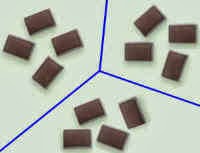Multiplication and Division Of Whole Numbers
The basics of multiplication is repeated addition. There are 6 conceptual models for multiplying two numbers. The six conceptual models are: multiplication as repeated addition, the array model for multiplication, the rectangular area model for multiplication, the skip-count model for multiplication, the multiplication tree model, and the Cartesian product model. I will be going over these models more in a bit. The basics of division is splitting into equal parts or groups, also known as "fair sharing." There are three conceptual models for division of whole numbers. The three conceptual numbers of division are: the repeated-subtraction model, the partition model, and the missing-factor model. These models will also be explained in more details.
The sixth model is the Cartesian product model of multiplication, is an ordered pair (a,b) of objects, where the first component a of the ordered pair indicates the type of object and the second component b of the ordered pair indicates the other object. An example is with two shirts and three pairs of pants, you could have 2 • 3, or 6, different shirt-pant combinations.
The six models of multiplication: each model provides useful conceptual and visual representation of the multiplication operation.
The first model is multiplication as repeated addition, is when a and b are any two whole numbers and the product is found from them. (a*b=b+b+...+b when a doesn't equal 0, when 0*b=0) An example of this is, if we are combining 7 groups with 4 objects in each group we can arrive at the same answer with addition. 4+4+4+4+4+4+4=28 is equivalent to 7*4=28.
The second model is the array model for multiplication, is finding the product when items like numbers or objects are arranged in rows or columns.
The third model is skip-count model for multiplication, is when you skip by the number b exactly a times. An example is five times 3, start with 0 and skip to 3 as our first position, then skip 3 more to 6 our second position. We then skip 6 to 9 third position, 9 to 12 fourth position, and 12 to 15 fifth and final position. We have skipped 3 five times to get 15.
The fourth model is the rectangular area model of multiplication, is when you use the dimensions of the rectangle to correspond to the factors and the area of the rectangle corresponds to the value of the product.
The fifth model is the multiplication tree model, is a way to show solutions for counting problems. An example of this isif there are 4 flavors of ice cream—chocolate, vanilla, strawberry, and mint—and 2 types of cones, sugar and waffle, how many different choices of ice-cream cones are possible?The sixth model is the Cartesian product model of multiplication, is an ordered pair (a,b) of objects, where the first component a of the ordered pair indicates the type of object and the second component b of the ordered pair indicates the other object. An example is with two shirts and three pairs of pants, you could have 2 • 3, or 6, different shirt-pant combinations.
The three conceptual models for division: the division a divided by b of a whole number a by a nonzero whole number b.
The first model is the repeated subtraction model of division, is realized easily with physical objects and is also called division by grouping. An example is 28/4=7 28-4=24-4=20-4=16-4=12-4=8-4=4-4=0
The second model is the Partition model of division, is also realized with physical objects and also called division by sharing. An example is
The third model is the missing-factor model of division, is based on inverse operations.
An example is 28/4=7 28=4*c or 28=c*4







